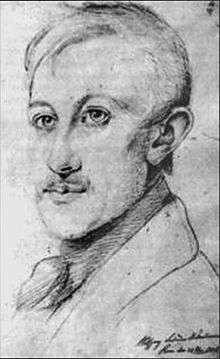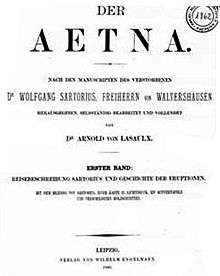Wolfgang Sartorius von Waltershausen

Wolfgang Sartorius Freiherr von Waltershausen (December 17, 1809 – March 16, 1876) was a German geologist.
Life and work
Waltershausen was born at Göttingen and educated at the university in that city. There he devoted his attention to physical and natural science, and in particular to mineralogy.[1] Waltershausen was named after Johann Wolfgang von Goethe, who was close friends with his parents.[2] Waltershausen's father, Georg, was a writer, lecturer and professor of economics and history at Göttingen. Georg Sartorius (later Sartorius von Waltershausen) is best known in his role of translator and popularizer of Adam Smith's Wealth of Nations. Waltershausen's son, August, was a well known economist who studied the American economy, and had at least one of his books translated into English.

During a tour in 1834-1835 Waltershausen carried out a series of magnetic observations in various parts of Europe. He then gave his attention to an exhaustive investigation of the volcano of Mount Etna, in Sicily, and carried on the work with some interruptions until 1843 including with Christian Heinrich Friedrich Peters. The chief result of this undertaking was his great Atlas des Ätna (1858–1861), in which he distinguished the lava streams formed during the later centuries.
After his return from Mount Etna, Waltershausen visited Iceland, and subsequently published Physisch-geographische Skizze von Island (1847), Über die vulkanischen Gesteine in Sizilien und Island (1853), and Geologischer Atlas von Island (1853). Meanwhile, he was appointed professor of mineralogy and geology at Göttingen, and held this post for about thirty years, until his death.
In 1866 Waltershausen published an important essay entitled Recherches sur les climats de l'époque actuelle et des époques anciennes; in this he expressed his belief that the Ice age was due to changes in the configuration of the Earth's surface. He died at Göttingen.[1]
In 1880, Arnold von Lasaulx edited Waltershausen notes and published the book Der Aetna (cover page pictured).
Gauss zum Gedächtnis
Waltershausen was also the author of Gauss zum Gedächtnis, in 1856. This biography, published upon the death of Carl Friedrich Gauss, is viewed as Gauss's biography as Gauss wished it to be told. It is also the source of one of the most famous mathematical quotes: Mathematics is the queen of the sciences.[3] and the famous story of Gauss as a young boy quickly finding the sum of a long string of consecutive numbers[4]
When Gauss died in Göttingen, two individuals gave eulogies at his funeral: Gauss's son-in-law Heinrich Ewald, and Waltershausen who represented the faculty in Göttingen.


Commemorations
The mineral Sartorite[5] as well as the Waltershausen Glacier in Northeast Greenland73°52′N 24°20′W / 73.867°N 24.333°W were named in his honour.
Notes
- 1 2
 One or more of the preceding sentences incorporates text from a publication now in the public domain: Chisholm, Hugh, ed. (1911). "Waltershausen, Wolfgang Sartorius, Baron von". Encyclopædia Britannica. 28 (11th ed.). Cambridge University Press. p. 297.
One or more of the preceding sentences incorporates text from a publication now in the public domain: Chisholm, Hugh, ed. (1911). "Waltershausen, Wolfgang Sartorius, Baron von". Encyclopædia Britannica. 28 (11th ed.). Cambridge University Press. p. 297. - ↑ See link to see title page of book of their correspondence.
- ↑ Variants include: "Mathematics is the queen of sciences and arithmetic the queen of mathematics. She often condescends to render service to astronomy and other natural sciences, but in all relations she is entitled to the first rank" and "Mathematics is the queen of the sciences and number theory is the queen of mathematics (Die Mathematik ist die Königin der Wissenschaften und die Zahlentheorie ist die Königin der Mathematik.).
- ↑ See for discussion of original sourcing by Wolfgang Sartorius von Waltershausen.
- ↑ de:Sartorit
External links
- Works by or about Wolfgang Sartorius von Waltershausen at Internet Archive
- Works by Wolfgang Sartorius von Waltershausen at LibriVox (public domain audiobooks)

- Digitized English Translation of Waltershausen book on Gauss, Gauss zum Gedächtnis, 1856.
- - Satorite Mineral Page
- - 2nd Satorite Mineral Page
- - Discussion of Waltershausen as source on Gauss numbers story including partial translation of Waltershausen book on Gauss [American Scientist online Volume 94 Number: 3 Page 200 Gauss's Day of Reckoning: A famous story about the boy wonder of mathematics has taken on a life of its own, Brian Hayes]
- Peters' information
- - Waltershausen's parents' page and information on Waltershausen family website
- - Waltershausen's son's page and information on Waltershausen family website